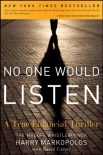No One Would Listen: A True Financial Thriller by Harry Markopolos (rainbow fish read aloud .txt) 📗

- Author: Harry Markopolos
Book online «No One Would Listen: A True Financial Thriller by Harry Markopolos (rainbow fish read aloud .txt) 📗». Author Harry Markopolos
That began changing again in the 1990s bull market. The hedge fund world exploded once more; by the turn of the new century there were an estimated 4,000 hedge funds investing about half a trillion dollars. Hedge funds long ago had stopped being conservative money management firms; a hedge fund meant simply an investment fund run as a private partnership and limited to wealthy investors and institutions. They were basically unregulated and invested in all types of financial instruments. While Madoff didn’t acknowledge that his money management operation was a hedge fund, that’s the way he was set up. He accepted money from high-income investors, institutions, and other funds and supposedly invested it. Supposedly.
Madoff’s unique structure gave him substantial advantages. As far as we knew at the time, the only entrance to Madoff was through an approved feeder fund. That meant his actual investors couldn’t ask him any questions, and they had to rely completely on their funds—who were being well rewarded—to conduct due diligence. I knew about the world’s biggest hedge funds: George Soros’s Quantum Fund, Julian Robertson’s Tiger Fund, Paul Tudor Jones’s Tudor Fund, Bruce Kovner’s Caxton Associates, and Lewis Bacon’s Moore Capital. Everybody did, and we estimated they each managed about $2 billion. Both Neil and I had read Jack Schwager’s Market Wizards, which profiled the most successful investment managers, and Madoff wasn’t even mentioned. So when we started trying to figure out how much money Madoff was running we were stunned. Absolutely stunned. According to what we were able to piece together, Madoff was running at least $6 billion—or three times the size of the largest known hedge funds. He was the largest hedge fund in the world by far—and most market professionals didn’t even know he existed!
There was no logical explanation for what we had discovered. It was like going out for a nice stroll and discovering the Grand Canyon. It was just so hard to believe. Neil and I didn’t have faith in the numbers, we didn’t believe in the numbers, we knew that numbers can’t lie. If our math was correct—the 6 percent correlation to the market, the steady 45-degree return, the number of options Madoff would have to own to carry out his strategy—(and we continually checked our math), the largest hedge fund in history appeared to be a complete fraud.
We never actually initiated an investigation. We never discussed it. Suddenly we were in the middle of it. We had no specific objectives; we just wanted to figure out what was going on. We started by gathering as much information as possible about Madoff’s operation. Frank, meanwhile, was continuing to meet with potential clients. Generally in those meetings the portfolio managers would outline their investment strategy and Frank would probe, looking for an opportunity. Among the managers he met with during this period was the Broyhill All-Weather Fund, a hedge fund of funds. In 1980 the Broyhill family had sold its South Carolina furniture manufacturing business and established an investment fund. As the manager of that fund, Paul H. Broyhill, pointed out, “It’s a whole lot easier to make money when you’re not losing it.” Frank met several times with Broyhill representatives in the lobby of a New York hotel. They showed Frank their product, which they explained was steadily producing 1 percent a month, and asked Frank if he could find a bank to guarantee it. As it turned out, the fund depended basically on two managers the Broyhill representatives would identify only as Manager A and Manager B. They handed Frank a promotional pamphlet and a single page showing Manager B’s returns.
Frank took one look at it and knew it was Madoff. Either this was an amazing coincidence and Frank had chanced upon two of the few funds investing in Madoff or he was much larger than we had imagined. We began to wonder how far into the industry his tentacles extended.
This material was the first solid evidence we had found. As soon as Frank handed it to me, I began breaking it down. “The manager’s investment objective is long term growth on a consistent basis with low volatility,” Broyhill’s fund description began. It explained that the fund utilized “a strategy often referred to as a ‘split-strike conversion,”’ which meant purchasing a basket of stocks with a high degree of correlation to the general market. Madoff’s subtle—but unspoken—message was that he had access to trade flow information because clients were buying and selling through his brokerage, so he knew what stocks were going up. Well, I had already proven that was false. But then it continued, “To provide the desired hedge the manager then sells out of the money OEX index call options and buys out of the money OEX index put options. The amount of calls that are sold and puts that are bought represent a dollar amount equal to the basket of shares purchased.”
Well, that was interesting. Like many people, Neil and I had been actively trading OEX options, but we had stopped and substituted S&P 500 options in the mid-1990s when these options, called the SPX, came to dominate the market and the S&P 100 OEX index options fell by the wayside. We were trading large





Comments (0)